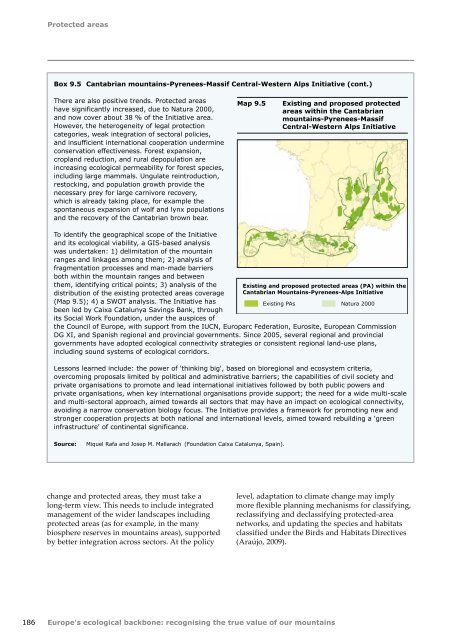Europes ecological backbone.pdf
Europes ecological backbone.pdf
Europes ecological backbone.pdf
Create successful ePaper yourself
Turn your PDF publications into a flip-book with our unique Google optimized e-Paper software.
Protected areas<br />
Box 9.5 Cantabrian mountains-Pyrenees-Massif Central-Western Alps Initiative (cont.)<br />
There are also positive trends. Protected areas<br />
have significantly increased, due to Natura 2000,<br />
and now cover about 38 % of the Initiative area.<br />
However, the heterogeneity of legal protection<br />
categories, weak integration of sectoral policies,<br />
and insufficient international cooperation undermine<br />
conservation effectiveness. Forest expansion,<br />
cropland reduction, and rural depopulation are<br />
increasing <strong>ecological</strong> permeability for forest species,<br />
including large mammals. Ungulate reintroduction,<br />
restocking, and population growth provide the<br />
necessary prey for large carnivore recovery,<br />
which is already taking place, for example the<br />
spontaneous expansion of wolf and lynx populations<br />
and the recovery of the Cantabrian brown bear.<br />
Map 9.5<br />
Existing and proposed protected<br />
areas within the Cantabrian<br />
mountains-Pyrenees-Massif<br />
Central-Western Alps Initiative<br />
To identify the geographical scope of the Initiative<br />
and its <strong>ecological</strong> viability, a GIS-based analysis<br />
was undertaken: 1) delimitation of the mountain<br />
ranges and linkages among them; 2) analysis of<br />
fragmentation processes and man-made barriers<br />
both within the mountain ranges and between<br />
them, identifying critical points; 3) analysis of the<br />
distribution of the existing protected areas coverage<br />
(Map 9.5); 4) a SWOT analysis. The Initiative has<br />
been led by Caixa Catalunya Savings Bank, through<br />
its Social Work Foundation, under the auspices of<br />
Existing and proposed protected areas (PA) within the<br />
Cantabrian Mountains-Pyrenees-Alps Initiative<br />
Existing PAs Natura 2000<br />
the Council of Europe, with support from the IUCN, Europarc Federation, Eurosite, European Commission<br />
DG XI, and Spanish regional and provincial governments. Since 2005, several regional and provincial<br />
governments have adopted <strong>ecological</strong> connectivity strategies or consistent regional land-use plans,<br />
including sound systems of <strong>ecological</strong> corridors.<br />
Lessons learned include: the power of 'thinking big', based on bioregional and ecosystem criteria,<br />
overcoming proposals limited by political and administrative barriers; the capabilities of civil society and<br />
private organisations to promote and lead international initiatives followed by both public powers and<br />
private organisations, when key international organisations provide support; the need for a wide multi-scale<br />
and multi-sectoral approach, aimed towards all sectors that may have an impact on <strong>ecological</strong> connectivity,<br />
avoiding a narrow conservation biology focus. The Initiative provides a framework for promoting new and<br />
stronger cooperation projects at both national and international levels, aimed toward rebuilding a 'green<br />
infrastructure' of continental significance.<br />
Source:<br />
Miquel Rafa and Josep M. Mallarach (Foundation Caixa Catalunya, Spain).<br />
change and protected areas, they must take a<br />
long-term view. This needs to include integrated<br />
management of the wider landscapes including<br />
protected areas (as for example, in the many<br />
biosphere reserves in mountains areas), supported<br />
by better integration across sectors. At the policy<br />
level, adaptation to climate change may imply<br />
more flexible planning mechanisms for classifying,<br />
reclassifying and declassifying protected-area<br />
networks, and updating the species and habitats<br />
classified under the Birds and Habitats Directives<br />
(Araújo, 2009).<br />
186 Europe's <strong>ecological</strong> <strong>backbone</strong>: recognising the true value of our mountains

















